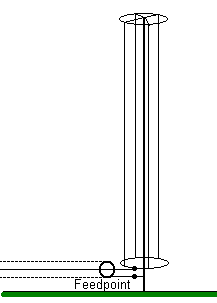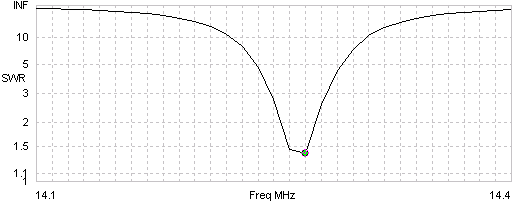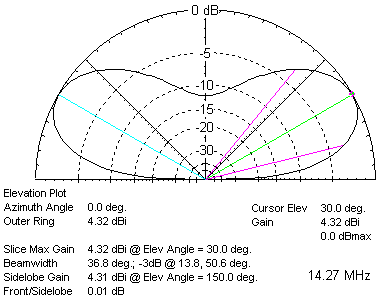Author: Frederick R. Vobbe, W8HDU
March 1, 2009
| Antenna 016: 20 Meter Uni-pole Vertical Author: Frederick R. Vobbe, W8HDU March 1, 2009 |
 A uni-pole antenna, (seen to the left), is a grounded pole with a vertical skirt around the pole. A uni-pole antenna, (seen to the left), is a grounded pole with a vertical skirt around the pole.
The nice thing about the Uni-pole is that the pole is at ground potential. The signal is fed to the skirt, and travels upward to the top where it connects to the pole, then flows downward to ground. This design is somewhat like a closed dipole element. This antenna was designed for 20 meter operation, 14.2000 MHz. The ground system under the antenna was (24) 25-foot radials. The pole was 34-foot long, and was supported by rope. The first version was installed on the shore of Lake Erie, and several of the radials dropped into the lake. I didn't see any real advantage to the radials being in or out of the water. But I was amazed that the impedance was fairly stable considering that most of the antenna was on sand, and the old deep ground we had was a piece of rebar that was hammered into the beach. I'm sure it made connection with wet sand underneath, but I still would expect to see as much as 1000 ohms resistance to real ground. Sand can be a good insulator. Over the two days this antenna operated I think we had pretty good results. The calculated impedance was 6 ohms, but in the field it approached more along the lines of 15+j20. The other thing I noted was that the bandwidth of the antenna was somewhat limited. See the plot below.  At 14.2700 MHz I had a pretty good match, but tuning off to 14.300 and the match deteriorated rapidly. When running calculations on the antenna it's easy to see why this happens.
The one thing to note from this table is that the measured impedance pretty much hovers around the 6.20 mark with j going positive and negative. To me, this indicates that we can easily tune out this match. A tuner at the base of the tower, or a "T" network consisting of a coil and capacitor in series, with a coil to ground, would be sufficient.  Note that the takeoff angle is typically at 30 degrees, and ever with 500 KHz variance will change only by 1 degree. This makes this vertical antenna useful in HF communications. A few years ago myself, and a few friends, came up with some interesting installations of uni-poles. One installation consisted of a wire skirt attached to an abandoned mall parking lot light pole. The pole, which was about 33 feet tall, was ideal as it was all aluminum pole construction. A 14" stainless hose clamp allowed us to attach 24 radials to the base that fanned out into the parking lot.
We operated for three days from the parking lot and had good results. I believe that some of the RF was impacted by nearby light poles, but for the most part anything we heard on 20 meters we could work! When we tried this antenna on 40 meters we had some difficulty. We had to fight with the tuning, which seemed to be the best with a match of 1 : 1.37 and a calculated impedance of 308.7 -j200. When modelling this in EZNec it was easy to see that even with a top hat on the antenna, (consisting of 4 nine-foot long CB antennas), we were too short for good 40 meter operation.  Still, I wouldn't write off the Uni-pole as a failure. It still had some useful qualities. And when you consider that this could be designed into an existing tower, it might offer some additional options at times. Frederick R. Vobbe, W8HDU |
 |
© Copyright 2008 All Rights Reserved - W8HDU |